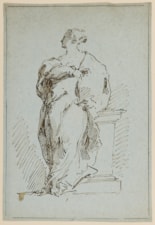Pietro Antonio NOVELLI
(Venice 1729 - Venice 1804)
A Standing Draped Female Figure Leaning on a Pedestal
Numbered 38 on the verso.
Inscribed (in a modern hand) Novelli on the verso.
283 x 197 mm. (11 1/8 x 7 3/4 in.)
The outlines of Pietro Antonio Novelli’s long career are known through his posthumously published memoirs, which appeared thirty years after his death. Trained in the studio of Giambattista Pittoni, he also came under the influence of Gaspare Diziani and Francesco Guardi, while his earliest paintings – a Saint Joseph in the Venetian church of Santa Fosca and a Presentation in the Temple in the church of San Francesco in Rovigo, both painted in 1759 – show the influence of Jacopo Amigoni. Among other early documented works are a set of illustrations for an edition of Torquato Tasso’s Gerusalemme Liberata, published in 1760, and several plates for the complete edition of Carlo Goldoni’s Commedie, published in 1761 and 1788. In 1768 Novelli was accepted as a member of the Accademia in Venice, for whom he submitted an Allegory of the Arts as a reception piece.
Novelli painted frescoes in several Venetian palaces, including that of the Corniani-Tivan, Mangilli, Mocenigo and Sangiatoffetti families, and also painted altarpieces and decorative frescoes throughout Northern Italy; in Udine, Padua and Bologna, as well as in Venice. Indeed, ‘Novelli was one of the most active participants in the great wave of decorative painting that swept Venice and the Veneto in the last thirty years of the Venetian republic.’ Among the artist’s patrons was Catherine the Great, Empress of Russia, for whom in 1772 he painted a mythological composition as a pendant to a work by Pompeo Batoni. By 1779 Novelli had settled in Rome, where he worked for most of the next twenty years, and where he came under the influence of Neoclassicism and such artists as Batoni and Anton Raphael Mengs. During his years in Rome he completed a ceiling painting of Cupid and Psyche for the Villa Borghese and received commissions for the decoration of several Roman palaces. The last years of his career were spent in Venice. His son Francesco Novelli followed in his father’s footsteps as an engraver and designer of prints and book illustrations.
Novelli is best known today for his drawings. He was an inventive and versatile draughtsman, and, as one contemporary source noted, ‘The drawings and painted works by Novelli showed not just a profound knowledge, but also a supreme degree of fantasy, and I myself saw him change in ten and more ways the same subject.’ His many and varied drawings – executed in both pen and ink and watercolour and, more rarely, in red chalk - include studies for paintings and altarpieces, as well as a significant number of designs for book illustrations, prints and frontispieces. Large groups of Novelli’s lively and colourful drawings are today in the collections of the Museo Correr in Venice, the Ecole des Beaux-Arts in Paris, the Cooper-Hewitt National Design Museum in New York and the Albertina in Vienna.
As one scholar has noted of Novelli, ‘He was an extremely versatile artist, drawing on Venetian, Bolognese and Roman traditions in his altarpieces and frescoes. However, Novelli is at his most impressive as a draughtsman, whether working economically with the pen…or delicately brushing on complementary shades of wash…With his multifarious talents, Novelli could well be regarded as the Palma Giovane of his time - both artists worked in Rome and Venice and attempted to combine the virtues of academic classicism with Venetian painterliness; Palma and Novelli were prolific draughtsmen, and both had to live with the achievements of far greater artists in view.’
Provenance
Bought from her for £5 by P. & D. Colnaghi, London
Sold by them for £10 in May 1951 to Jack (later Sir Jack) Baer, London
Thence by descent.
Exhibition











